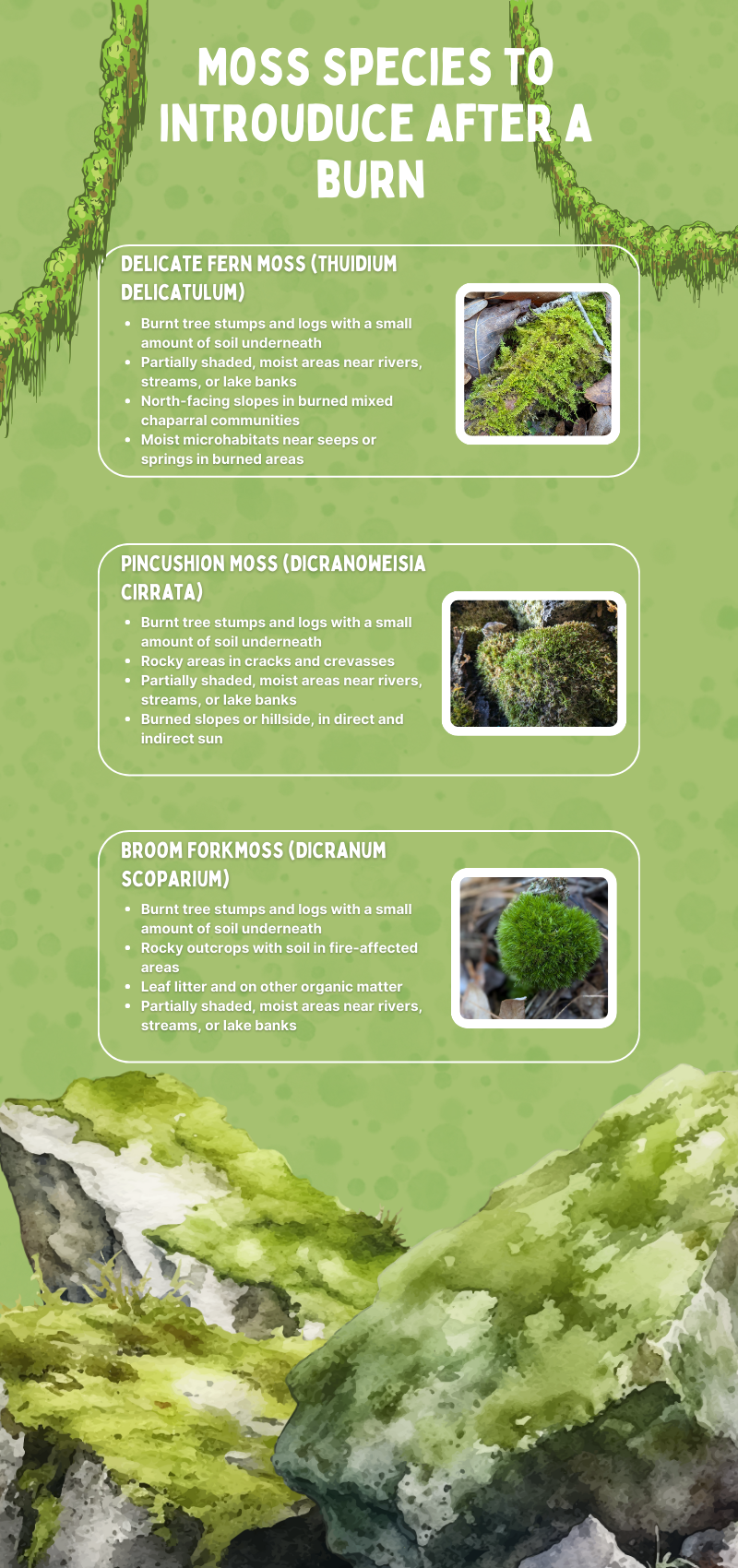As of late January 2025, the Palisades wildfires have consumed more than 20,000 acres. While much of the land was residential and businesses, the parks and wildlife were not left unscathed. As local and national governments work to provide aid, so does nature, in the form of our little green friend, moss. From deserts to the Arctic, its role in preserving water, nutrients, and sustaining life in micro-environments will be a key component to rebuilding the flora and fauna after these fires.

Why moss?
After an intense wildfire, stumps and ash are often all that remain. A landscape reduced to mere inches, but within these inches, new life first begins.
Often this first life is moss. Moss is a resilient little plant that is not only able to withstand long periods of dryness but even at times wildfires, depending on intensity. Parks like Will Rogers State Historic Park (SHP) and Topanga State Park (SP) suffered huge losses but may still contain our green friend along the various hummocks and cracks within the earth and rock. This is because moss is able to hold on to a large amount of moisture due to its cell structure.
Moss is actually designed to hold water, like a sponge. In fact, some moss can hold 20 times its weight in water. This seems high, as moss lacks the root structure of a typical plant. Instead of deep roots, moss collects and stores water within its cells. Through capillary action, mosses draw water by creating stronger adhesive forces between water molecules and their surface, enabling them to absorb moisture from their environment and survive in diverse habitats.
Holding on to water not only helps the moss but aids the rest of the ecosystem as well. When saturated, moss is able to act like a small greenhouse on the surface, preserving water vapor and other gases that are needed for plants like trees, ferns, and bushes. If you go outside your home now and find a patch of moss, you will likely see grass, ferns, and maybe even a tree sapling growing out of it. This is because moss can act as a safe harbor for plants to begin germination, restarting the growth of the forest fauna.
However, building up new life still requires a solid foundation, and depending on the intensity of the fire, the soil may pose issues.
When a forest burns, it not only takes the trees and bushes but also the Soil Organic Matter (SOM). Most soil contains sand, silt, clay, etc., and the organic matter is what helps to hold the water and bind these particles together. With the soil not being as porous, it can’t hold on to as much water, leading to more runoff. In some cases, the soil can become hydrophobic. Moss is able to help mitigate these issues by holding on to the valuable nutrients and organic matter needed for plants to grow and establish root systems to help further bind the soil together.
When to add moss to a burned ecosystem?
It’s already started. Moss is spread by spores, and they exist everywhere, even in the air we breathe. These spores have already begun spreading throughout Will Rogers State Historic Park (SHP) and Topanga State Park (SP) along with other burned areas and will continue to do so. But just because a moss spore lands does not mean it will take hold. Among the many things moss needs, the most important are moisture and time. Moss grows slowly, and I mean slowly; some of the moss patches you’ve seen baked onto rocks can be well over a century old. Now it won’t take a century to start setting growth in forest; it will likely only take days as weeds, grasses, and ferns jump in to start filling gaps. Moss slowly takes hold and sprouts up these pioneer species.
What kinds of moss should be introduced and where should they be?
Let me start by saying don’t go throwing moss across a forest and hope for the best. You are more than likely wasting your time as the moss will just dry out or blow away before it takes hold. You will want to focus on getting the right moss in the right location. Below is an infographic of a few species of moss that are native to CA and where it would likely be best to add them.

Warning: DO NOT take moss from parks or places where you do not own the land or have expressed permission to do so. You could get in legal trouble and harm the environment you are trying to appreciate.
Growth takes time
Moss is only part of the solution to wildfire recovery. There are many other flora and fauna that need to make their way back in to start colonizing the affected areas. At the time of writing this, California has already lost 57,000 acres this year, with the Palisades and Eaton fires causing over 23,000 acres so far. And the fires are still going today.
To keep up with the latest information on the wildfires in California, you can check out the 2025 incident archive for CA Fires.
Leave a Reply